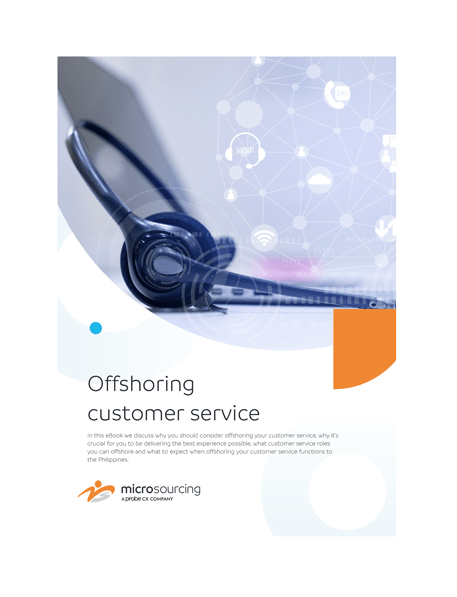
Why you should consider offshoring your customer service
Customer service essentially has the power to make or break your business - it’s key to business success. By delivering top-notch customer service your business can increase customer retention and acquisition rates which will ultimately lead to improved margins and profitability.
The importance of customer service
Customer service is evolving. Fast. And you have to keep up. We’re now seeing many online companies provide exceptional levels of 24/7, multi-channel customer service. It’s becoming the norm; your customers now expect you to do the same. Which means you’ll need to get creative, because you don’t have the same resources at your disposal as the Amazons of this world. Plus, it’s not as simple as it used to be. There are a lot more platforms businesses need to support these days, including:







As a result, customer service has evolved from 9-5 on business days to 24/7, 365 days a year. Leaving customers with little patience when expecting a response. A recent survey suggested that a third of people who leave a comment on your social media page expect a response within 30 minutes. The remaining expect a response within the day. Businesses need to meet that expectation and react quickly in order to provide the best service and remain competitive. If you want to keep up with customer expectations and thrive in this new environment, you’ll need to invest in smarter tools and approaches - like offshoring.
Why offshore your customer service
Every savvy business operator has considered offshoring. Between globalization and the ever-increasing cost of local labor, you’d be crazy not to. But, when customer service is at the forefront of your business, it’s natural for you to be hesitant about sending it offshore.
However, customer service lends itself really well to the offshore model. It’s usually a high volume activity - quite repetitive and process-driven. Plus, customer service roles can be hard to fill onshore. All of these factors mean offshoring your customer service is a smart choice. You get:





Hiring onshore customer service is challenging
Providing good customer service is challenging for businesses at any stage or size. But small businesses can find it especially hard to deliver the service quality their clients and customers expect. The most common reasons are:
- Onshore staff are expensive - statistically speaking, labor costs are the second-biggest expense for most businesses
- You need a lot of people
- You need to invest in them (and their training)
- Onshore customer service teams can suffer disproportionately from high turnover rates.

What to expect from customer service offshoring
We’ve all heard the horror stories, and we’ve all been on the receiving end of terrible offshore phone support. But the truth is, those experiences, while not uncommon, are by no means a good representation of what outsourcing can really do. Done right, an offshore customer support team can not only save you money, but can also deliver measurable service quality improvements including:




Being prepared is a key component that will ensure your outsourcing journey is ‘done right’. To help, here’s what you can expect when hiring an offshore team of customer service representatives in the Philippines.
Why the Philippines?
The Philippines is one of the largest English speaking countries in the world. This means that language barriers aren’t an issue when offshoring to this particular country. Filipinos also have the tendency of being loyal, hard-working and honest - three characteristics that make for an excellent customer service representative.
Hospitality is also a big part of the Philippines’ economy, so most existing industries are already customer service oriented. Not to mention the fact that large multinational American and Australian companies have invested in customer service personnel and training in the Philippines for decades, meaning the Philippine labor market is now rich and skilled in talent. And at all levels - junior, intermediate and senior. This means you can quickly set up a team, with all the experience you need, and they’ll hit the ground running.

Talent acquisition
Your outsourcing provider should be running a rigorous recruitment process to identify the strongest candidates in the pool. Skills and language testing should also be conducted before you’re involved in the recruitment process. This will ensure that you have a high quality talent selection to choose from.
From there, here is how to ensure you’re choosing the right candidate.
- Firstly, spend enough time interviewing each candidate. And don’t just focus on their skills; make sure they’re a good fit for your company culture too.
- Secondly, after you’ve finished interviewing each candidate, provide detailed feedback on why they passed or failed. This will help your recruitment team filter your candidates in the future.
- Finally, make sure you have clear KPIs in place. Once you’ve hired and trained your new team member, they’ll rely on you to communicate your expectations for the role. By giving your staff clear and measurable indicators of success, you’ll motivate them to meet (and exceed) your expectations.
It’s also important to note that monitoring your changing needs is crucial. This is often overlooked once the business fills their first allocation of offshore roles, but it’s equally as important as defining your needs up-front. Wherever you employ, at home or offshore, you’ll have staff turnover, and it’s important you learn from your experiences, and adapt your needs, expectations and approach accordingly.
Training
In theory, training offshore employees shouldn’t take any longer than training onshore employees, so between 2-3 weeks depending on the complexity of the role. There’s a common misconception that your offshore team members will come trained and ready to go. And while they do come trained, to an extent, this particular misconception is what causes a lot of negative outsourcing experiences. Your outsourcing provider should provide your new staff members with HR and operations orientations, which includes a site tour and initial systems testing.
Once completed, training is then handed over to you for company orientation, systems training, an introduction to your products and services, and workflow training. This training period will depend on your individual business needs and the types of roles you’re filling. A common concern when we discuss training is ‘how will I be able to train my team if I can’t sit with them’. A fair concern but also one that is quickly forgotten about once we explain how it works.

Outsourcing wouldn’t be as easy as it is today without technology. By utilizing online communication tools such as Skype or Zoom, you are able to train your offshore team exactly how you would if they were sitting in the office next to you. You can screenshare and record your sessions so that your team has something to refer to if they are lost on what to do.
Tech
Realistically, all your offshore team needs is a desktop, a webcam, a headset, access to web conferencing software and a reliable internet connection. However, it’s the technology that you decide to use internally that will determine the efficiency of your team.
We always recommend for our clients to integrate a cloud-based program if not previously used before. Some common cloud based programs include GSuite and Dropbox. These particular programs allow you to share and collaborate with your offshore team whenever, wherever.
We also recommend that you integrate a project management tool like Monday or Asana to track deadlines and deliverables. These entry level programs are so easy to use and can make a real difference to your teams output.
Structure
This all depends on the size of the team. For a smaller team, you may need to hire more senior staff upfront. This is what a lot of start ups do - and also clients that are trying offshoring for the first time, before expanding. This approach is also very helpful as you grow, because the senior staff can eventually take on the leadership roles and train junior staff.
If you’re hiring a larger team upfront, it’s a similar approach, but you should first look for people who are experienced in leadership and management, not just in customer service. This will ensure you have streamlined communication and reporting, and that someone in your offshore team can help you screen and interview subsequent roles, and focus on effective team engagement, culture and retention.

Want to set up a 24/7 team? We’ve seen plenty of businesses do this successfully, once they get a few essentials in place. First, you need to account for extra staff to cover the hours needed, as 24 hours per day is a fair bit more than the standard 9-5. Plan ahead for holiday, sick leave, and turnover by having at least a few extra staff available to cover any vacancies, depending on the size of your team.
What’s next
Outsourcing your customer service can come with its challenges, but with the right provider your business will be on its way to providing the best customer service in town.
If you want to learn more on the above topics, including common offshoring customer service mistakes and real-life success stories, then download the full version of our ‘Offshore customer service’ eBook today. Just fill in the form below.